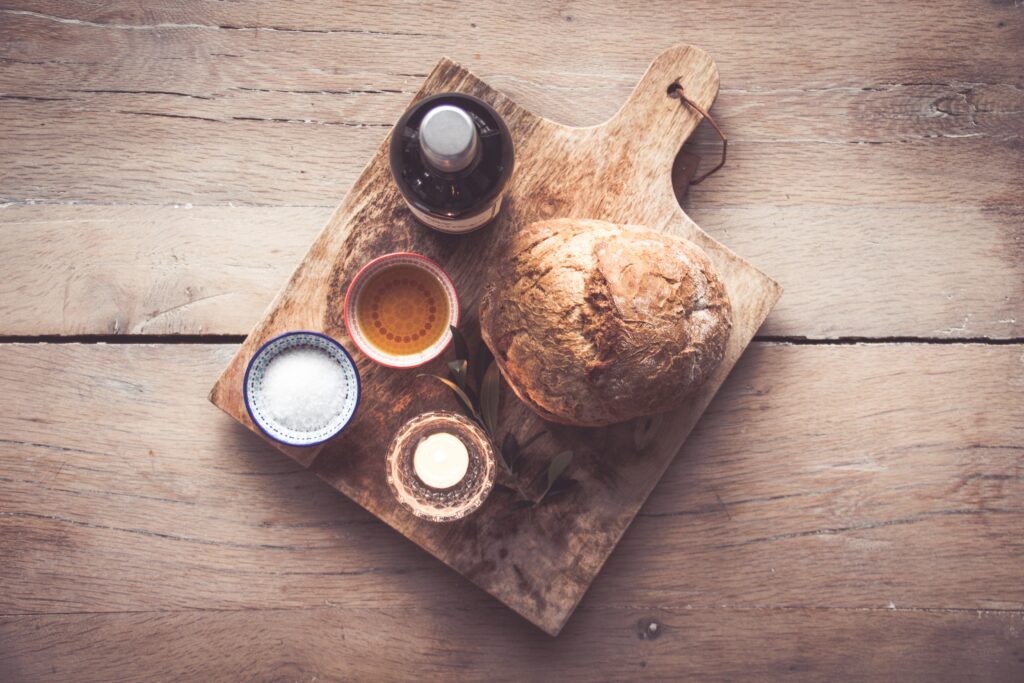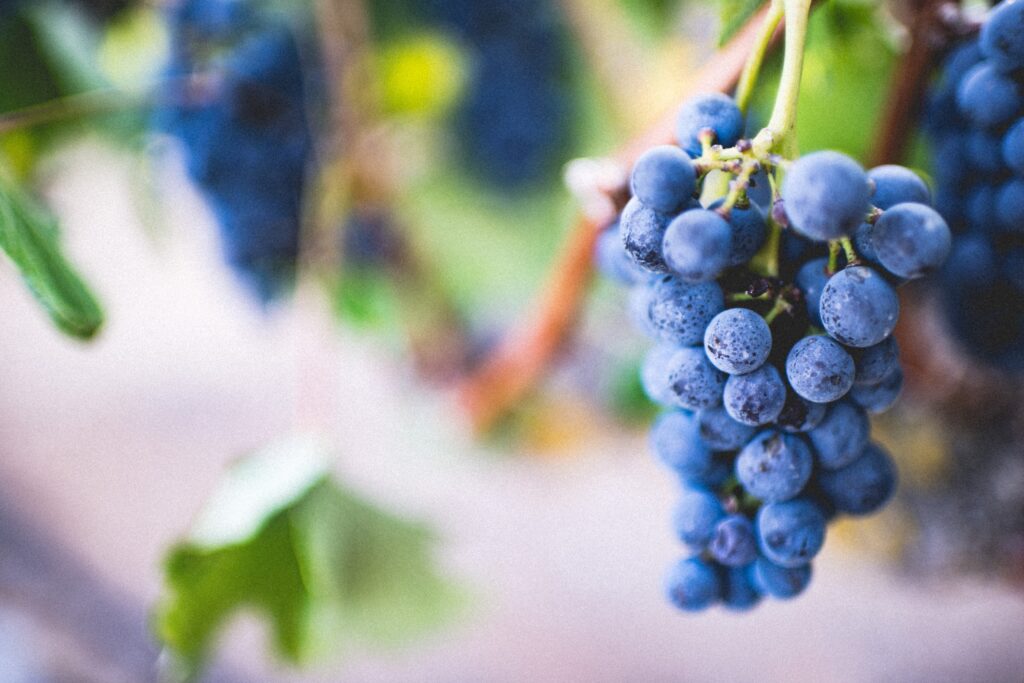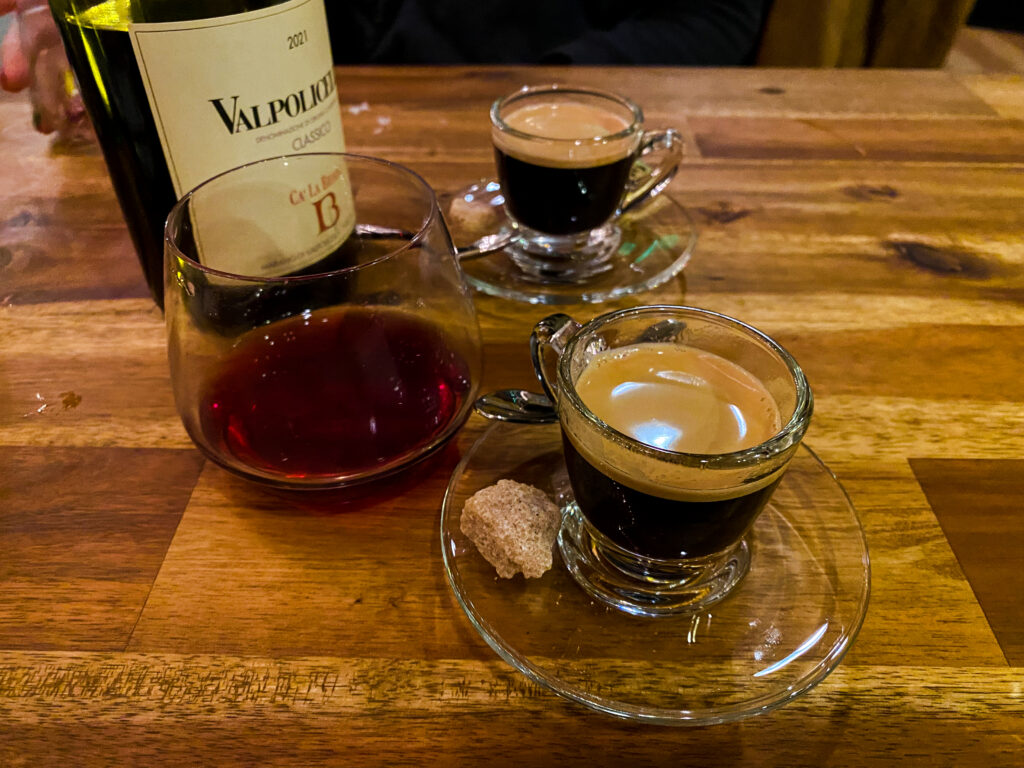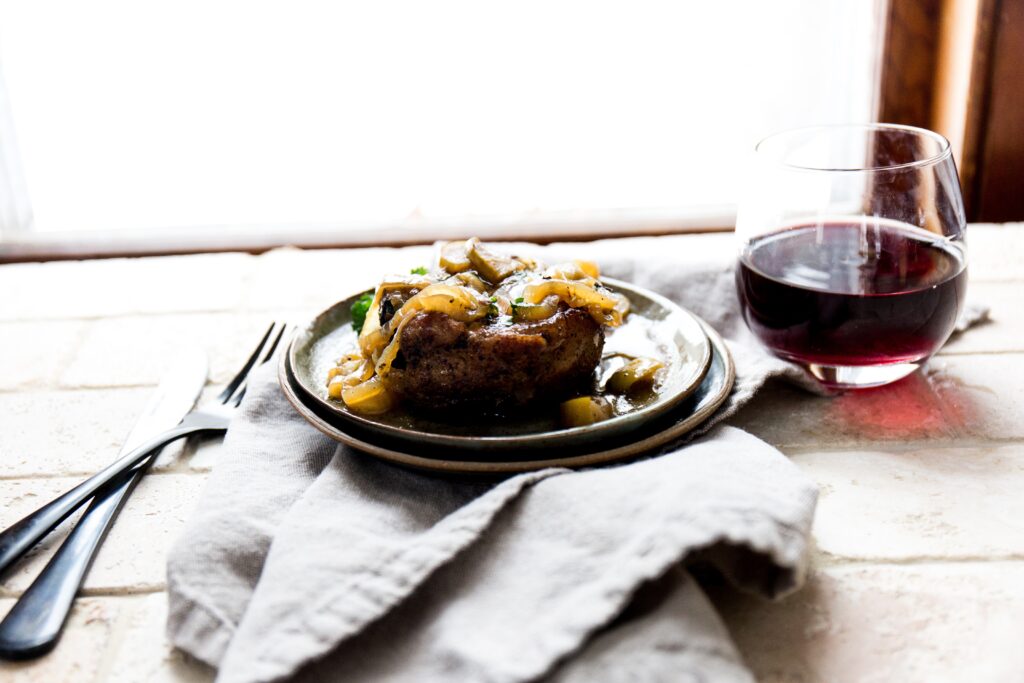When it comes to pairing wine with food, the options are literally endless. Luckily, you don’t have to be a professional sommelier or agonize over every bottle to make a wonderful pairing for one – or many – courses.

Keep reading to learn quick tips, a step-by-step guide, tons of excellent recommendations, and how to break all the rules and still have a phenomenal pairing!
Top Tips for Wine & Food Pairing
There are six flavor profiles to remember when it comes to pairing wine and food: Sweet, acid, salt, spicy, fat, and bitter. All food pairings come down to deciding which of those flavors are in the food, then picking a wine that either accentuates those flavors or contrasts them.
Here are some general rules of thumb to consider when pairing wine and food:
| If the food is… | Then the wine should be… |
| Acidic | More acidic |
| Sweet | Sweeter |
| Spicy | Off-dry, sweet, and or acidic |
| Salty | Tannic and or acidic |
| Fatty | Tannic and or acidic |
| Bitter | Off-dry, sweet, and or acidic |
Wine & Food Pairing, Step-by-Step
The abovementioned tips are a perfect jumping-off point, but with a little extra knowledge in your noggin, you can make a basic wine pairing even better.
By identifying the key elements of the dish, then deciding whether to compare or contrast those flavors, you can narrow down your choices even if you don’t have a wealth of wine knowledge under your belt.
Step One: Identify the Main Flavors in the Dish
First things first, identify the main flavor profile in the dish. This is probably easier said than done since most dishes can hardly be categorized as just “salty” or “fatty.” That said, if you can pick out one or two flavors that stand out, it will help to narrow down your options.
Ex. Spaghetti and meatballs are acid and salt; collard greens are bitter and salt.
Pro tip: When pairing a protein in a sauce, pair according to the sauce instead of the protein.
Step Two: Pair to Accentuate or Pair to Contrast
Once you’ve decided what flavors are in your dish, decide if you want to pair to accentuate or contrast those flavors.
Accentuating pairings will create balance and amplify the shared flavors found in both the food and the wine.
Ex. Buttered popcorn and buttery Chardonnay; Barbeque with Syrah
Contrasting pairings will do just the opposite. They will showcase the differences in flavor and allow both to shine independently.
Ex. Port and blue cheese; Fried chicken and Champagne
In general, bitter, sweet, and spicy foods pair best with contrasting pairings. While Acidic, fatty, and salty foods pair best with accentuating pairings. So, if your dish is acidic and salty, you might want to consider a wine pairing that accentuates those flavors.
Ex. Spaghetti and meatballs are acidic and salty and best paired with a wine that is also acidic and has robust tannins.
Step Three: Get a Little More Specific
While you could certainly stop with step two, identifying more nuanced flavors in the food and wine can help to make for an even stronger pairing. So, I encourage you to dig a little deeper. Does the dish have spices, fresh herbs, dried herbs, or a minor ingredient such as capers or olives?
Ex. Spaghetti with Italian herb-infused meatballs.
Step Four: Niche Down the Wine
Then, once you have a style of wine in mind, narrow down your choices to wines that pair well with those nuanced ingredients.
Ex. Dried herbs are bitter, so best to stick with a less robust red wine, such as a medium-bodied Sangiovese.
See how easy that was? Don’t get me wrong, pairing spaghetti with Cabernet would not have been a national catastrophe or even a failed pairing. That said, if you’re willing to dive a little deeper, I guarantee you’ll notice the difference a few minor details can make.

More Helpful Tips
- If it grows together, it goes together- When in doubt, stick to wines nearest to the region’s cuisine you’re serving.
- Lean proteins, lightly flavored, and mild dishes generally pair best with white and rosé wines
- Hearty proteins, richly flavored, and robust dishes generally pair best with red wines
- The intensity of the wine should match the intensity of the dish
How to Break the Rules and Get Away With It
Rules were made to be broken, so now that you’re familiar with the tried-and-true tips for food and wine pairing, here are a few notable exceptions:
Pairing red wine with fish
Fish oils generally do not pair well with tannins in red wine. That said, red wines with low tannins, such as Gamay Noir and Pinot Noir, can be perfect for balancing the fishy flavors and highlighting other ingredients in the dish.
Serve red wine chilled
Most red wines are best served at room temperature at 60°-68°F, though some red wines will benefit from being served slightly below room temperature, around 54°-58°F.
This helps maintain the fresh fruitiness of lighter-bodied red wines, like Gamay Noir, while softening intense wines such as Petite Sirah.
Serve white wine room temperature
Most still white wines are served around 45°-50°F, but I find that to be too cold for most white wines, as it tampers down the more nuanced tropical and stonefruit flavors. So, I tend to serve my white wines at a slightly-chilled temperature, around 54°F.
My rule of thumb is that if the glass becomes cloudy with condensation when you pour the wine then it’s too cold! Let it hang out for a few minutes, or (gasp!) cup the glass with your hands to release those more delicate aromas.
Pro Tip: Most refrigerators are too cold to keep a wine “slightly chilled” so I recommend letting the wine sit on the counter for 20-30 minutes before serving.

Pairing Recommendations
Now that we’ve covered the basics, here are some wines I have found to be wonderfully versatile and fit to pair with a whole host of dishes.
Pinot Noir
Pinot Noir is a red wine typically light-to-medium in body with bright acidity, mild tannins, lower in alcohol, and rich with bright fruit flavor. It’s one of my favorite red wines for tricky pairings where you might otherwise select a white wine. It’s also my favorite for a salmon wine pairing!
What I’m drinking: Lemelson Thea’s Selection Pinot Noir 2019
Pinot Noir food pairing suggestions: Thanksgiving turkey, salmon, creamy pasta, anything with mushrooms
GSM/Rhône Blend
The GSM is a common red blend found in the Rhône Valley of France. It is a blend of Grenache, Syrah, and Mourvèdre, plus a dozen or so lesser known grapes. It’s typically medium in body, tannins, and acidity. Its bright red fruit, dried herb, and delicate flavor of baking spices make it an ideal pairing for leaner proteins like chicken as well as barbequed and roasted meats.
What I’m drinking: Famille Perrin Chateauneuf-du-Pape Les Sinards 2019
GSM food pairing suggestions: Pizza, burgers, roasted chicken, charcuterie
Chablis/Unoaked Chardonnay
Chardonnay is a hard wine to love for some, since many are so buttery and rich that they overpower the dish they’re paired with. I thought this too – until I discovered Chablis. Chablis is an unoaked Chardonnay from northern Burgundy and produces 100% Chardonnay with entirely stainless steel.
Unoaked Chardonnay is much more crisp, with bright acidity and no buttery or toasted flavors. It makes for a wine more akin to Pinot Grigio, but with tropical flavor and more full in body.
What I’m drinking: Domaine Drouhin Vaudon Chablis 2020
Unoaked Chardonnay food pairing suggestions: Cheese boards, shrimp scampi, oysters, pork tenedrloin
Provençal Rosé
Provençal Rosé refers to rosé wine from the Province region of southeastern France. This region makes a variety of well-known and more obscure wines, mostly blends. The region’s rosé wines, in particular, are wonderfully fresh, snappy, and perfectly balanced with bright red fruit and mineral notes. This is a go-to wine selection for all things fresh seafood.
What I’m drinking: Maitres Vignerons de la Presqu’ile de Saint-Tropez ‘Fleur de Mer’ Rose 2017
Provençal Rosé food pairing suggestions: Bouillabaisse (fish stew), green salad, tapenade, roasted veggies
Champagne/Sparkling Wine
I love sparkling wine, especially because it is a surefire way to kick off the evening and pairs with everything from fried finger foods to salty cheeses to creamy sauces. Champagne in particular is bright, vivacious, and rich with lemon, bruised apple and brioche notes. Prosecco, Cava, Crémant, and all other sparkling wines are equally good choices for pairing with rich and salty dishes.
What I’m drinking: Charles de Cazanove Tête de Cuvée Champagne N.V.
Champagne food pairing suggestions: Fried chicken, mushroom ravioli, mac ‘n cheese, truffles
Off-Dry Riesling
Last but not least, Riesling with subtle sweetness (AKA residual sugar) is high in acid and possesses lovely flavors of citrus, green apple, honeycomb, and stonefruit. This is a perfect food pairing wine for your more tricky pairings such as spicy or bitter cuisines.
What I’m drinking: Trimbach Alsace Riesling 2020
Off-dry Riesling food pairing suggestions: Sushi, Indian curries, Thai food

FAQs
Asparagus, sushi, soy sauce, brussel sprouts, artichokes, and vinaigrettes are historically hard to pair with wines since they have clashing flavors that make them unfriendly to most wines. That said, I think dry or off-dry Riesling, Pinot Grigio, and Chardonnay are all good pairing options.
Pair to compliment or pair to contrast are the two basic rules you must understand in order to pair food and wine.
You can never go wrong with a display of meat, fruit, and cheeses. I usually find prosciutto, fresh melon, sharp cheddar cheese, olives, and crackers all make for excellent charcuterie boards that will pair well with most wines.

